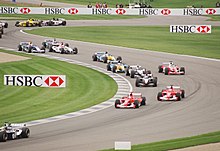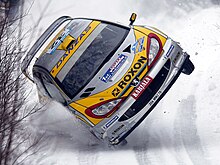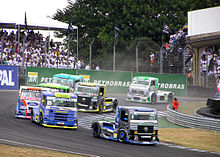Motorsport
The Motorsport includes all sports that the most rapid or clever move motor -driven vehicles have their drivers to the target. Essentially, these are automobile racing as well as karting , motorcycle racing and motorboat racing . In addition, competitions with special vehicles such as tractors ( tractor pulling ), trucks ( truck racing ) or airplanes ( air races ) are also part of motorsport.
While most of the motor sports are carried out on closed, purpose-built racetracks , rally racing in particular also takes place on public roads, which are closed for this purpose. Some events, such as the Dakar Rally , are often held with off -road vehicles away from roads and slopes, for example in desert regions such as the Sahara .
Illegal street races are not counted as motorsport . They do not meet the standards of modern sport, in particular the rules of fairness and not endangering third parties. Since they do not take place on closed roads or on their own race tracks, but in other road traffic, other road users and participants in the race are endangered.
The competition called “ From Beijing to Paris in an automobile ” was one of the first “racing events” to be announced in 1907. A thirst for adventure, the urge for technical progress and athletic motivation were the driving forces behind the first motorsport enthusiasts.
history
Beginnings around 1900
Motorsport developed in the late 19th century from the races of the first owners of motor vehicles. Due to the poor road conditions and the insufficiently developed vehicle technology, the reliability and resilience of the vehicles in particular had to be confirmed. In races against riders , cyclists and railways , higher top speeds could be achieved, but the endurance speeds were not yet satisfactory in view of the frequent problems. In the absence of a petrol station network , small quantities of fuel were obtained from pharmacies .
Although these activities mostly attracted a large public response, the manufacturers of motorized means of transport initially kept their distance from these events, as their vehicles were primarily intended for driving comfort and were not designed for holding races.
Until one registered the advertising effectiveness of racing successes, normal "series products" were used first. Only after various successes did the motorcycle and automotive industries slowly develop out of the bicycle industry .
Similar to cycle races ( Tour de France ), races with automobiles or motorcycles were usually advertised by large daily newspapers (L'Equipe, Daily Telegraph, Chicago Tribune etc.). These were grueling tours or races from one city to another. The first race with automobiles led from Paris to Rouen on July 22, 1894 ; the first hill climb on January 31, 1897 from Nice over a total of 17 kilometers up to the mountain village of La Turbie . The race from Paris to Madrid was stopped prematurely in 1903 after several deaths. Among others, one of the Renault brothers had an accident. Was limited then mostly on shorter courses, but were repeatedly passed through, as the first grand prix at Le Mans Thus arose in 1906. addition to street racing , the circuit races .
The longest car race from New York via Beijing to Paris in 1908 led over more than 21,000 kilometers through mostly impassable terrain. Only half a dozen cars took part at the time, the weakest car only had 15 hp. The winner, George Schuster, was on the road for 169 days.
Interwar period
Before the First World War it was motifs such as the demonstration of steadfastness and perseverance, the inter-war period determined the motif of the intoxication of speed. In the meantime, thanks to the engine turbocharging that had been further developed for the air war, the engines were now capable of higher performance than was necessary for normal road traffic.
For the first time, special racetracks were built that allowed high speeds, such as the AVUS in Berlin with its two long straights and a banked curve or Monza in Italy, also with banked curves. In Spa-Francorchamps , Belgium , a triangular course made up of country roads was expanded by introducing bypasses for high speeds.
However, technical progress was faster than could be imagined around 1934 when new rules for Grand Prix racing were introduced. As early as 1937, the racing cars achieved outputs of over 500 hp and top speeds of over 300 km / h, and in record drives even over 400 km / h. The speeds of motorcycles also increased: in 1929 Bert le Vack set a world record with 207.73 km / h, in 1937 Eric Fernihough set a new world record on a Brough Superior with a JAP engine with 273.244 km / h.
After the Second World War
After the Second World War, it was necessary to continue to operate at pre-war levels for some time. However, a new generation of technical engines was already emerging in the early 1950s. At the end of the 1950s, panels appeared on motorcycles and streamlined bodies on automobiles. From the 1960s onwards, better chassis and tires made it possible for vehicles with relatively weak engines to reach high speeds on winding racetracks. A new problem arose: safety for participants and spectators. There were serious accidents with numerous deaths. Racing events were banned, works racing teams withdrew from active motorsport.
Racing remained very dangerous. It was not until the end of the 1960s that the risk of injury was managed to such an extent that the risk of injury in both the professional classes and in the increasingly popular sports sector, through the renovation of the racetracks (creation of run-off zones ) and the introduction of seat belts, roll bars, fireproof clothing , that the end of the In the 1970s, personal injuries to drivers and even spectators decreased.
Audience numbers
There was also a change in the audience area over time. Before the First World War, people only drove on gravel roads or on racing courses with concrete tracks. The spectators could literally stand in the street on open stretches; there were already grandstands at the circuits. It wasn't much different in the interwar period. However, there have been quite a few races on concrete tracks. After the Second World War, races experienced real spectator booms: well over 100,000 spectators lined the racetracks. They stood crowded on the roadsides, and it was often a miracle that nothing happened. The Grenzlandring near Mönchengladbach, for example, saw between 200,000 and 300,000 spectators at each of the five races held from 1948 to 1952; On August 31, 1952, with at least 13 deaths (according to some sources there should have been a 14th, unknown death) and 42 injured, it was also the scene of the most fatal racing accident in Germany to date.
Declining visitor numbers at the end of the 1950s and beginning of the 1960s led to the end of numerous racing events.
Until the 1960s, spectators could literally stand up close to the racetracks and wander through the paddock . With regard to the proximity to the routes, however, the organizers - at least in Germany - became increasingly aware of their responsibility (see above, accidents with spectators) and installed safety fences, run-out and safety zones. In some cases, access to the paddocks was also banned. From the audience's point of view, this varies significantly from sport to sport. The opportunities to establish direct contact with the athletes themselves, especially in the commercial sector, have consistently deteriorated.
Nowadays, especially the international motorcycle grand prix and formula 1 races, as tightly organized commercial events, have strayed far from the origins of motorsport, also in terms of audience numbers.
The situation is different in the case of events that can be assigned more to popular sport, e.g. B. Motocross , Rallye 200 , but also in the Rallye Deutschland as a World Championship run, in kart races or in the automobile slalom .
Legal situation in Germany
Non-profit
While initially the legal opinion prevailed that motorsport was not competitive sport because the actual sporting performance emanated from motorized sports equipment, motorsport now generally fulfills the requirements for non-profit status (see Federal Fiscal Court of October 29, 1997, Az.IR 13/97 , BStBl II 1998 p. 9).
natural reserve
The approval procedures for motor sport events outside of demarcated sports facilities are becoming more complicated due to increasing nature conservation regulations. However, it is possible to combine motorsport with nature conservation issues. A significant problem is often the large number of spectators, which can put more stress on a landscape than the motorsport equipment. See also DMSB environmental guidelines.
The Advisory Council for the Environment and Sport at the Federal Ministry for the Environment, Nature Conservation and Nuclear Safety presents motorsport as not environmentally friendly. In a statement, it expresses the opinion that, with regard to the concept of nature and landscape compatibility, sporting activities in the great outdoors apply that the nature conservation regulations Sufficient sporting activities are compatible with nature and the landscape, unless they are carried out using internal combustion engines. Arrival and departure are not included.
See also
Web links
- Link catalog about motorsport at curlie.org (formerly DMOZ )
- German Motorsport Association V. (DMV)
- General German Motorsport Association V. (ADMV)
- German Motor Sport Association V. (DMSB)
- Deutscher Sportfahrerkreis e. V. (DSK)
- General German Automobile Club (ADAC)
- Motorsport definitions (Engl.) ( Memento of 28 February 2007 at the Internet Archive )
- Austrian Motorcycle literature and image archive
Individual evidence
- ↑ Axel F. Busse: The mother of all car races. In: welt.de . February 23, 2008, accessed October 7, 2018 .
- ↑ BFH judgment of October 29, 1997 (IR 13/97) BStBl. 1998 II p. 9
- ↑ DMSB environmental guidelines ( Memento from May 18, 2015 in the Internet Archive ) (PDF; 1.8 MB)
- ↑ Advisory Board for Environment and Sport at the Federal Environment Ministry ( Memento from September 29, 2007 in the Internet Archive )





